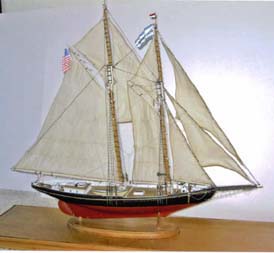
American fishing schooner, 132' length
Scale - 1:48
Basswood and brass, britannia metal fittings, cotton sails, Kit built by Jack Lindley

This schooner was designed by Thomas McManus and built in Essex, Connecticut and carried a crew of 15 that fished for mackerel using seine nets. In 1906 she moved to New York and sailed for Fulton Fish Market as a dory-trawler, carrying small boats (dories) that were lowered to the sea, from which crew set trawl lines. The ship was lost off Puerto Rico in 1943.
Bluenose II, 1963Canadian fishing schooner, 145' length
Scale - 1:48
Basswood, pine and cherry; linen sails and rigging, Scratch-built by Victor Buhrke
The original Bluenose was launched in Canada in 1921 to compete in the International Fishermen's Races. She won in 1931 and in 1938, the last race.
She was also a fishing vessel. Twice a year she sailed from New England to the Grand Banks off Newfoundland to fish for cod. In the winter she sailed to the West Indies with a cargo of salt cod and then returned north with a hold full of salt. She sank off Haiti in 1946.
The replica Bluenose II was built as a tribute to the Canadian fishing fleet.
BrookesModel of a slave ship, late 18th century
The British anti-slavery campaigner William Wilberforce used this famous model of a slave ship to demonstrate to Parliament the horrors of conditions on board. The slaves endured the entire three-month transatlantic crossing from Africa to the West Indies shackled together by hand and foot. Plantation owners bought them to work in sugar, cotton or tobacco fields. The British abolished the slave trade in 1807.
USS Constitution, 1798Three-masted frigate, 175' length

The U. S. Navy was born in 1794 when Congress asked for six warships to be built. The Constitution was one of those ships.
She had a crew of 460 men and carried 44 guns. During the War of 1812 she fought the British warship Guerriere, leaving it totally wrecked after only 30 minutes. During the battle the cannonballs bounced off the thick wooden sides of the American ship, leaving little damage. A sailor exclaimed, "Her sides are made of iron." That's how she got the nickname Old Ironsides.
The Navy said she was un-seaworthy about 1829. But Oliver Wendell Holmes wrote a poem about the ship that made people want to save her. So she was rebuilt and is now on exhibit at the Boston Navy Yard.
Steam passenger launch, 40' length
Scale - 1:26
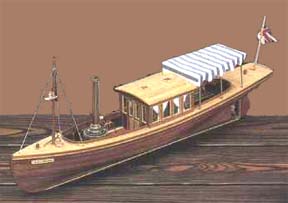
Basswood, mahogany, birch, Kit built and modified by Harold H. Patton
At the end of the 19th century, pretty little steam launches such as this carried passengers on the Thames River in the London area. A simple but efficient boiler system and reciprocating engine powered it. Their use spread to many areas of the world, and some are still in operation today.
Ferriby boat, ca. 1800 BCBritish Bronze-age stitched vessel, 52' length
Scale 1:48
Basswood
Scratch-built by Edward von der Porten (125 hours)
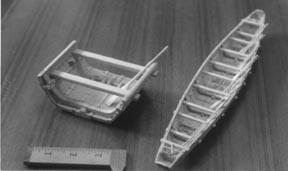
Two teenagers found a large boat fragment on the bank of the Humber Estuary at North Ferriby, Yorkshire, England in 1937. More fragments were found in later years. They were proved to have come from oak plank boats which had been shaped with bronze tools and then stitched together with thin strips of twisted yew. The Ferriby boat is believed to be the earliest boat found in Europe.
This is a model of a reconstruction of that boat. It is a stitched boat with no metal fittings. A cross section of the boat is shown to the left of the model.
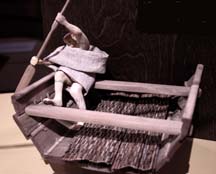
Scale 1:12
Basswood, cording, Scratch-built by John Kopf
The cross-section is reconstructed from boat fragments found in North Ferriby, Yorkshire, England. This model shows the details of joinery and caulking, along with the probable paddling position.
Galleon, ca. 1550Spanish, 130' length
Basswood, Kit built and modified by Ivan Klitgaard
This ship might have brought Oriental treasures from the Philippines to Mexico or New World silver to Spain.
She is also typical of the larger, three-masted, full-rigged ships that formed the fighting part of the Spanish Armada. Philip II organized this fleet of 130 warships in 1588 to invade England and take over the English throne. Despite the Spanish strength of 2,000 cannon and 20,000 men, the Spaniards were defeated in the English Channel. Escaping by sailing around Scotland and Ireland, they were caught in storms and only 60 ships found their way back to Spain.
Halve Maen (Half Moon), 1609Dutch bark-rig, 65' length
Scale - 1:50
Mahogany, walnut, and other woods, Stern lantern, figurehead and window frames scratch-built, Kit built and modified by Jerome Blair
Hired by the Dutch East India Company to find a Northeast passage to the Indies, Henry Hudson used the Halve Maen to try both East and West passages. In 1609 he reached Cape Cod and the Chesapeake before exploring the Hudson River up to Albany.
In his fourth expedition, in 1610, Hudson hoped to find the Northwest Passage. Between Greenland and Labrador he sailed up a strait and reached a bay - Hudson's Bay. Ice forced him to winter there, and the next summer his starved and diseased crew mutinied and set Hudson, with his son and seven other men, adrift in a small boat without food or water. He was never seen again.
Hercules, 1907Steam tug, 151' length
Scale - 1:72
Wood, Scratch-built by Vaclav Niedermentl
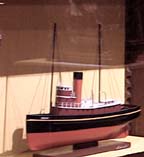
The Hercules towed barges, sailing ships and rafts of Northwest lumber up and down the Pacific coast. During the construction of the Panama Canal, she towed a huge floating caisson (a steel structure used for closing the entrance to locks) to the Canal Zone. After the Western Pacific Railroad Company bought the Hercules, her career changed significantly. She no longer served as an ocean-going tug, but shuttled railroad car barges back and forth across San Francisco Bay. By 1962, the decline of the railroads and the introduction of diesel-powered tugs ended her working days.
The California State Park Foundation acquired her for the San Francisco Maritime State Historic Park in 1975. The National Park Service took over the task of her restoration in 1977, and in 1986 she was designated a National Historic Landmark. The Hercules is in working condition and is open to visitors at the San Francisco Maritime National Historic Park at the Hyde Street Pier in San Francisco.
HMS Iris; ex USS Hancock, 1776-1793British (ex American) frigate, 136' length
Scale - 1:48
Home-milled timbers of pear, apple, madrone, maple and boxwood
Built "dockyard" style from plan no. 285 in British Admiralty Collection
Scratch-built by John Kopf (3,000 hours)
Built as one of the 13 original frigates ordered by the Continental Congress, the Hancock was captured by the British in 1777 and renamed HMS Iris. She was captured by the French in 1781, recaptured by the British in 1793 and destroyed at Toulon that same year.
Katy, 1850American pilot boat, 56'
Scale - 1:50
Pine, cherry and basswood, Scratch-built by Wes Weber
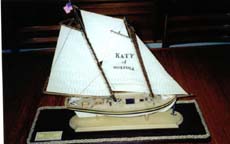
Pilot boats carried port pilots to and from large ships entering harbors. Each harbor developed its own type, according to the sailing conditions of the area.
Katy, 1850American pilot boat, 56' length
Scale - 1:50
Basswood, pine, cherry; linen rigging and sails, Scratch-built by Victor Buhrke
Here is a second model of the Katy. Pilot boats carried port pilots to and from large ships entering harbors. Each harbor developed its own type, according to the sailing conditions of the area.
King of the Mississippi, ca. 1900Mississippi stern wheeler, 120' length
Scale - 1:80
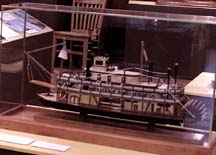
African walnut, sapelia and ramin, Kit built by Ivan Klitgaard
This is an example of the larger type of river boats that plied the Mississippi, Missouri and Ohio Rivers in the early 1900s, carrying freight and passengers.
Mary, 1660Dutch Royal pleasure yacht, 66' length
Scale - 1:54
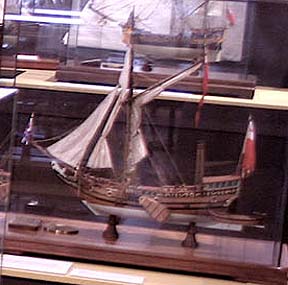
Holly decking, linen rigging and sails, Kit built and modified by Jean K. Eckert (Approximately 1,070 hours)
The City of Amsterdam presented this Dutch East India Company yacht to King Charles II of England when he returned to the throne. Charles had taken refuge in Holland during the time of the English Civil War and the rule of Oliver Cromwell. The ship was named after the King's sister and her use marked the beginning of English pleasure yachting.
The royal arms of England decorated the stern, while the figurehead was a unicorn. Mary was armed with eight small guns, and carved and gilded wreaths decorated each gunport.
Note the leeboard on the side, which could be lowered to reduce the rate of sideways drift due to wind direction. This allowed the ship to have a shallower keel, improved handling in confined spaces and could be raised in shallow water, convenient for a yacht likely to spend considerable time in shallow water. Small sailboats with a centerboard that can be lowered through the bottom of the hull make use of the same idea.
Nonsuch, 16508 gun ketch
Scale - 1:48
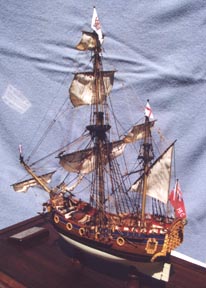
Beech, mansonia, boxwood, holly, deGama, linen rigging and sails: All ornamentation hand-carved
Model took a gold medal in 2000 Mariner's Museum contest
Scratch-built by Jean K. Eckert from plans for the 1968 reconstruction (Approximately 2,200 hours)
The original eight-gun ketch was built in Essex, England. She was the first ship used by the Hudson Bay Company in 1667. The 1968 reconstruction, built to celebrate the company's 300th anniversary, sailed in England, the Great Lakes, and both Canadian coasts. It is now in the Manitoba Museum of Man and Nature.
Pride of Baltimore II, 1989Baltimore clipper, 170' length
Scale - 1:64
Basswood and brass, britannia metal fittings, Kit built by Jack Lindley
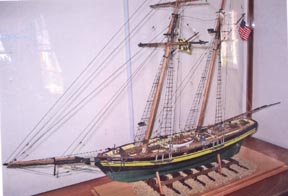
This ship was built as a tribute to the type of fast, highly maneuverable ship known as Baltimore Clipper, first built during the American Revolution. They were gaff-rigged schooners, although many had a square sail for driving power on the foremast. They could sail closer to the wind and were much more maneuverable than the full-rigged British ships of the time. There superior sailing performance led to their use as privateers against enemy merchantmen in the War of 1812.
The vessels had a V-shaped hull that could cut quickly through the waves. However, they had little cargo space, a major factor in their eventual decline.
Regina S., ca. 1900American scow schooner, 73' length
Scale - 1:48
Pine, pear, cherry, boxwood, Scratch-built by John O. Kopf
Scow schooners carried hay, produce and other merchandise between San Francisco, Sacramento, Redwood City and other bay area towns. Their broad, shallow hulls provided stability. Their use of centerboards or leeboards allowed them to move heavy cargo in waters too shallow for keelboats. The squared off bow and stern offered the maximum space for cargo.
Roter Lowe (Red Lion), 1597
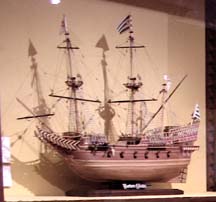
Dutch galleon
Scale - 1:55
Walnut, cherry, mahogany; brass and copper fittings and ornamentation, Kit built by Marvin Marshall
The Roter Lowe served as a sentry boat and cargo vessel under Capt. Peter Hintze with a crew of 30. She carried 12 iron guns firing iron shot on her lower deck, plus four others firing stone balls.
Royal Barge, ca. 1750European, 27' length
Scale 1:24
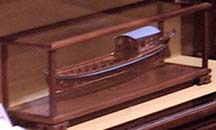
Madrone, pear, apple, cherry and boxwood, all home-milled, Scratch-built by John Kopf
This boat was moved by eight pairs of oars and carried royalty on rivers, harbors and inland waters.
British royal yacht, 90'
Scale - 1:48
Pear, madrone, apple and boxwood, all home-milled
Built in "dockyard" style, showing framing, Scratch-built by John Kopf (2,000 hours)
She was built for King George II and Queen Caroline, for pleasure sailing and crossing to Holland. She carried 24 guns, and was usually accompanied by four frigates.
Swift, 1805Virginia pilot boat, 65' length
Scale - 1:48
Plywood bulkheads, walnut, lime, Kit built by Roy Ozaki
This small, fast schooner ferried harbor pilots to inbound ships waiting offshore and retrieved pilots from outbound ships that had safely reached the sea.
Typical Viking ship, ca. 10th centuryScandinavian long ship, 76' length
Scale - 1:38
Scratch-built by Harold H. Patton
Many recent archaeological discoveries and replica ships' sailings have confirmed Viking ships' excellent design and seaworthiness. Their 1000-year-old design is still used in Danish and Norwegian small craft.
Toy Viking long ship
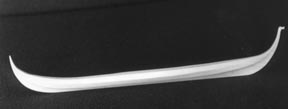
Scale - 1:2
Basswood, Scratch built by Edward von der Porten
This is a model of a toy ship from Hedeby, North Germany, a Viking town. The tops of the bow and stern, including the figurehead, are reconstructed, based on evidence from other finds.
Wasa, 1628Swedish Royal ship-of-the-line, 165' length
Scale - 1:100
Basswood, walnut, lime, Kit built and modified by Ivan Klitgaard
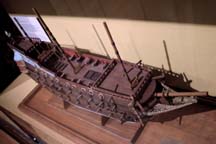
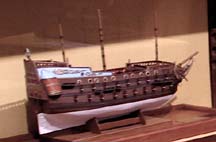
A noted Dutch naval architect designed the Wasa. The powerful warship was built for the fleet of King Gustavus II Adolphus during the Thirty Years' War. But at the launching it was obvious to everyone in the shipyard that she was a "tender ship." She was top-heavy!
Embarking on her maiden voyage she must have been a beautiful sight, brilliantly decorated with statues and bas-relief carvings. Then, in a slight wind, inside the Stockholm harbor, she rolled, flooded and sank in 100 feet of water.
Wasa was raised and restored in 1961, giving insight into the life and possessions of 17th-century Scandinavians. The ship is now on display in Stockholm.
 |
This page
last updated: October 29, 2007 Original content: Copyright © 2000 - 2007 Museum of American Heritage Trademarks are the property of their owners |